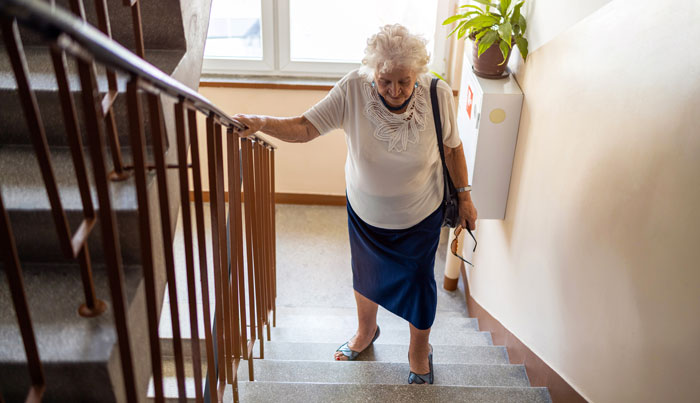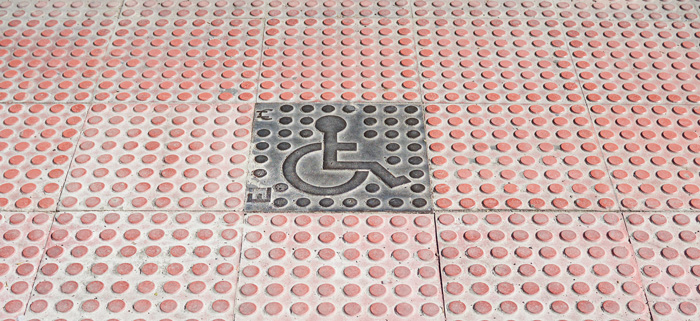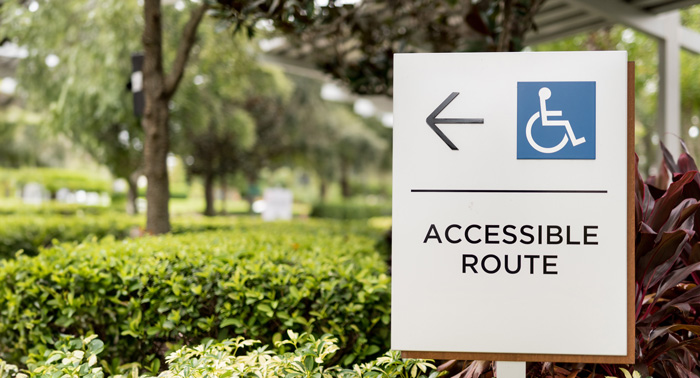
What is Universal Design?
In 1990, the Americans with Disabilities Act (ADA) established guidelines to provide barrier-free accessibility in all areas of public life, ushering in minimum legal requirements, such as providing wider doorways, ramps, and accessible parking spaces, to address the needs of people with disabilities. Universal design, also known as inclusive design, expands the concept of accessible design to mean “the design of products and environments to be usable by all people, to the greatest extent possible, without the need for adaptation or specialized design” as defined by the Center for Universal Design. Places often incorporate accessible design components that address a specific demographic group or specialized need, but universal design is intended to make places inviting to everyone.
Universal design is about making walkways, streetscapes, and environments in general more accessible and easier to maneuver for all people. With advances in health care allowing for people with disabilities to live longer and a growing aging population, universal design approaches that improve health, safety, and accessibility can help us to plan for more diverse groups of people and abilities, including the most marginalized members of the community, and allow us to create places for the whole community to enjoy.
Examples of universal design features include:
- Sidewalks or curb cuts are essential for people using wheelchairs, but also benefit kids riding bikes, seniors using walkers, parents pushing strollers, and delivery people pulling heavy dollies.
- Automated doors similarly help people with mobility impairments by eliminating the need to physically open or close doors, while benefiting people with strollers or other equipment, carrying heavy objects, or with limited hand strength.
- Wayfinding design can help people navigate places more clearly and intuitively. Multi-sensory interactive models can help people with visual impairments navigate the environment, but well-designed wayfinding elements that provide visual cues, including contrasting colors or tactile indicators, such as textured ground surfaces, can benefit everyone by making it easier to orient regardless of familiarity with a space and improve overall access for all users.
- Seats and benches that are placed on a level surface along an accessible path of travel can provide convenient and safe resting areas for people in public spaces..
Implementing universal design can be challenging due to perceived cost, resistance to change, conflicts with regulations, and lack of awareness or expertise preventing adoption. However, benefits include avoiding expensive and inefficient retrofitting, producing sustainable solutions, and creating inclusive places and environments for all individuals.

What is Visitability?
While universal design concepts and ADA standards address public spaces, commercial buildings and some residential buildings, there are other ways to create inclusive communities. Visitability is a term used to describe the idea that housing should be designed in a manner that is welcoming and comfortable for not only homeowners but all visitors, regardless of physical limitations or needs. When visitability was first coined by Eleanor Smith, the founder of Concrete Change, an advocacy network for visitability of homes, in 1987, a zero-step entry, first-floor bathroom, and wheelchair-accessible doorway (32 inches wide) were the qualifications required for homes to be deemed visitable. Over time, other characteristics, such as accessible outdoor pathways, first-floor bedrooms, and accessible light switches, have also been adopted as markers of visitability. These strategies are appropriate for not only those with limited mobility, but they also make spaces safe to move large objects, strollers, or furniture.
In the United States, single-family houses comprise more than 60 percent of housing stock (roughly 88 million out of a total 144 million units as of 2022), while about 35 percent of housing units were built before 1970. Dwellings that were built prior to federal statutes, like the Architectural Barriers Act of 1968 and Section 504 of the Rehabilitation Act of 1973, as well as many following, may need to be altered or residents may need to move to meet their physical abilities and maintain independent living. New homes that are visitable can allow for residents to be visited by family, friends, and others who may have disabilities, short-term stays for people with disabilities, and additional adaptations (like universal design features).
The Center for Universal Design’s Principles of Universal Design
The original concept of universal design was created by architect and industrial designer, and wheelchair user, Ronald Mace. He led a working group of architects, product designers, engineers, and environmental design researchers to create the seven principles of universal design to help guide the design process of environments, products, and communication.
- Equitable Use. The design is useful and marketable to people with diverse abilities.
- Flexibility in Use. The design accommodates a wide range of individual preferences and abilities.
- Simple and Intuitive Use. Use of design is easy to understand, regardless of the user’s experience, knowledge, language skills, or current concentration level.
- Perceptible Information. The design communicates necessary information effectively to the use, regardless of ambient conditions or the user’s sensory abilities.
- Tolerance for Error. The design minimizes hazards and the adverse consequences of accidental or unintended actions.
- Low Physical Effort. The design can be used efficiently and comfortably, and with minimum fatigue.
- Size and Space for Approach and Use. Appropriate size and space is provided for approach, reach, manipulation, and use regardless of user’s body size, posture, or mobility.
Guidelines for each principle can be found here.

Zoning for Universal Design and Visitability
Incorporating universal design and visitability into your community’s zoning ordinance can ensure that new development and redevelopment projects accommodate all individuals. Some standards that can help achieve greater adherence to universal design and visitability include:
- Education for homeowners and builders. Identifying desirable design components, such as accessible entrances, interior routes, adaptable bathroom and kitchen facilities, etc., will create new housing opportunities and promote greater inclusivity. Clearly defining critical terms related to universal design and visitability will also provide better direction during the development process.
- Planning with all users in mind. Setting goals for accessibility and inclusion in long-range planning can raise awareness of these issues and lay the foundation for improvements. Action items can lead to zoning changes, as well as tie into community capital improvement plans.
- Flexible zoning. Many zoning ordinances include Planned Unit Development (PUD) provisions to offer applicants zoning flexibility in exchange for desired public benefits. When this type of flexible zoning is offered, communities may consider universal design or visitability as a desired benefit.
- Incentives. Zoning regulations can provide developers with incentives when universal design and visitability features are incorporated into new projects, such as density bonuses or expedited permitting.
- Enforcement. Communities should enforce code requirements that impact visitability and access, such as blocked entryways or travel ways, unkempt properties, and conditions that limit or inhibit access.

CHEERS!
Join Us At Our Mixer!
2023 Planning Michigan Conference
Join us at the Michigan Association of Planning’s Planning Michigan Conference for a fantastic mixer! Connect with fellow planning enthusiasts, enjoy craft beers and appetizers, and dive into insightful discussions.
Date: Thursday, October 6
Time: 6:30 pm to 8:30 pm
Location: MiddleCoast Brewing Company
For more information, please contact Giffels Webster at 866.271.9663. www.giffelswebster.com



